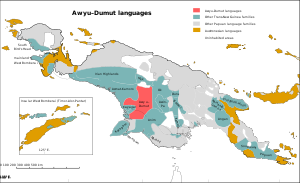Awyu–Dumut languages
| Greater Awyu | |
|---|---|
| Digul River | |
| Geographic distribution |
New Guinea |
| Linguistic classification |
Trans–New Guinea
|
| Subdivisions |
|
| Glottolog | grea1275 |

Map: The Awyu–Dumut languages of New Guinea
The Awyu–Dumut languages (other languages not shown)
Other Trans–New Guinea languages
Other Papuan languages
Austronesian languages
Uninhabited
|
|
The Greater Awyu languages, known in earlier and more limited classifications as Awyu–Dumut or Awyu–Ndumut, are a family of perhaps a dozen Trans–New Guinea languages spoken in eastern West Papua. Six of the languages are sufficiently attested for a basic description; it is not clear how many of the additional names (in parentheses below) may be separate languages.
The classification below is based on de Vries et al. (2012), who used morphological innovations to determine relatedness, as these can be obscured by loans. Further comparative work was done by Usher.
Sawi is classified on pronominal data, as the morphological data used for the rest of the family is not available. The pronouns of the Awyu–Dumut branch are:
The suffix *-p and the change of the final TNG *a vowel to *u do not appear in the possessive pronouns: *na, *ga, *ya/wa, *na-ga, *ga-ga, *ya-ga.
Various other languages can be found in the literature. Ario (Sumagaxe) is listed in Wurm, Foley, etc., but not in the University of Amsterdam survey and has been dropped by Ethnologue. Ethnologue lists a 'Central Awyu', but this is not attested as a distinct language (U. Amsterdam). In general, the names in Ethnologue are quite confused, and older editions speak of names from Wurm (1982), such as Mapi, Kia, Upper Digul, Upper Kaeme, which are names of language surveys along the rivers of those names, and may actually refer to Ok languages rather than to Awyu.
Bayono-Awbono may turn out to be Greater Awyu, or perhaps Ok.
van den Heuvel & Fedden (2014) argue that Greater Awyu and Greater Ok are not genetically related, but that their similarities are due to intensive contact.
The Awyu (pronounced like English Ow you) and Awyu–Dumut families were identified by Peter Drabbe in the 1950s.
Voorhoeve included them in his proposed Central and South New Guinea group. As part of Central and South New Guinea, they form part of the original proposal for Trans–New Guinea.
...
Wikipedia
